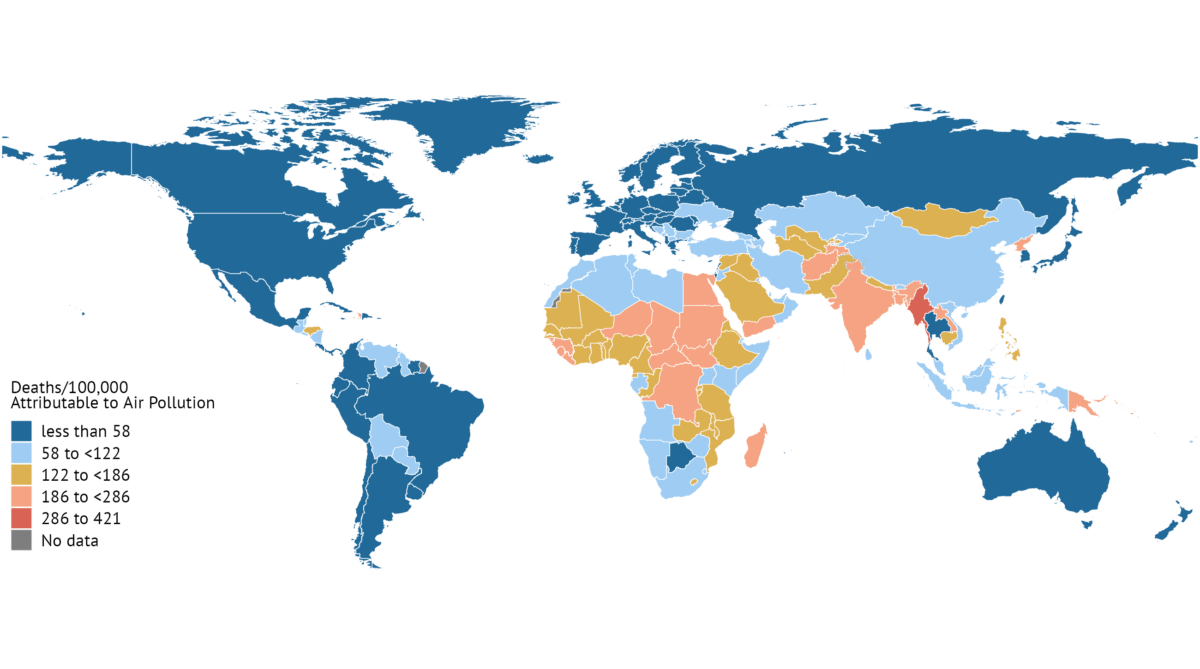Air pollution remains the second leading risk factor of death, according to the Health Effects Institute’s latest report, The State of Global Air 2025. Poor air quality resulted in 7.9 million deaths and 232 million healthy years of life lost in 2023.
Of these deaths, 86% were due to non-communicable diseases (NCDs), including chronic respiratory diseases, heart diseases, lung cancer, diabetes, and dementia.
The link between air pollution and NCDs
Decades of scientific research have linked exposure to air pollution with an increased risk for developing NCDs. People living with NCDs, as well as their families and caregivers, typically need more medical and emergency care, and experience productivity losses and a diminished quality of life.
In 2023, air pollution accounted for:
- 1 in 2 deaths from chronic obstructive pulmonary disease (COPD)
- 1 in 4 deaths from heart disease
- More than 1 in 4 deaths from dementia
As the global population is ageing, the burden of NCDs is continuing to grow, leading to the increasing need for air pollution mitigation. Between 2000 and 2023, the total number of NCD deaths attributable to air pollution increased by 13.5%, from 5.99 million to 6.8 million.
Ischemic heart disease, stroke, and COPD had the largest burden of disease attributed to air pollution in 2023. Given this large and increasing burden, action on air pollution is likely to be a key contributor toward reaching Sustainable Development Goal target 3.4 (reduce premature NCD mortality by one-third by 2030).
Regional disparities in air pollution’s impact on human health
More than 90% of air pollution deaths occur in low- and middle-income countries. Countries in South Asia and most of Africa see the double burden from both outdoor and household air pollution. Death rates in these regions are often 8-10 times higher than high-income countries.
When considering diseases, the differences are similarly large. Globally, air pollution contributes to 25% of deaths due to ischemic heart disease. In most of Africa and South Asia, this number can be as high as 35% while in high-income countries, only about 7% of heart disease deaths are due to air pollution.

Nearly 1 in 3 dementia deaths attributed to air pollution
Exposure to air pollution has been linked with neurodegenerative diseases, such as Alzheimer’s disease and other forms of dementia. In 2023, more than 600,000 dementia deaths and 11.6 million healthy years of life lost were attributable to air pollution, with 92% of deaths occurring amongst older people (70+ years).
Fine particulate matter, or PM2.5, contributes to neurodegeneration by entering the lungs, circulating in the blood, and flowing to the brain, where it causes inflammation and can damage brain tissue. Exposure to air pollution also increases the risk of heart disease, which can lead to dementia.
Signs of progress on clean air and health
Countries around the world are taking bold steps to reduce the impacts of air pollution. In Brazil, the adoption of a new National Air Quality Policy in 2024 has reinforced the country’s commitment toward improving public health, while Ghana and Uganda have taken concrete steps to address air pollution through national air quality regulations. Uzbekistan has become the first country in Central Asia to align its annual PM2.5 limit with the WHO Interim Target 1 of 35 µg/m3.
Looking ahead, the World Health Organization’s updated roadmap offers a clear target for countries: halve premature deaths from human-caused air pollution by 2040, relative to 2015 baseline values. Action towards improving air quality can help reduce health impacts, including the occurrence of stroke and heart attacks, poor birth outcomes, and cases of dementia and lung cancer, and reduce economic and societal impacts.
36% of the world’s population – 2.8 billion people – is still exposed to levels of PM2.5 that exceed the least stringent WHO interim target. There is a need to continue to bolster air quality data and integrate air pollution and NCD actions. With targeted interventions, public awareness, and a shared commitment towards clean air for all, a healthier future is possible.
The State of Global Air is a research and outreach initiative, providing reliable and up-to-date information on the health effects of air pollution globally. The initiative is a collaboration between the Health Effects Institute and the Institute of Health Metrics and Evaluation’s Global Burden of Disease project, providing free and publicly available data on the status of air quality and health outcomes in over 200 countries.
This year’s State of Global Air 2025 report has been produced in partnership with the NCD Alliance. Data for trends in exposures as well as health impacts for more than 190 countries is available via the State of Global Air data app.


